Welcome back to the blog! We’ve got something a bit different for you this week. Although of course we love our mountain chickens the most, we thought it was high time that we showed some appreciation for the other animals that call this island’s tropical paradise their home. Our volunteer, Rachel, is here to share with us some tales of lockdown lizards, intriguing invertebrates and the search party for a mysterious creature that has barely been sighted in years…
Montserrat is an island full of surprises. If you sit quietly, it is never long before an animal crosses your path, be it an agouti, a racer snake or a 4 foot long iguana that could easily be confused with a crocodile upon first glance. I’ve been lucky in that a lot of Montserrat’s wildlife has come to investigate me out of curiosity, but there are some creatures that continue to evade me, no matter how hard I search for them. Here is an account of some of the species I’ve been lucky enough to get to know and one that I have yet to meet. There is never a dull day on a tropical island!
Montserrat Ameiva (Pholidoscelis pluvianotatus)
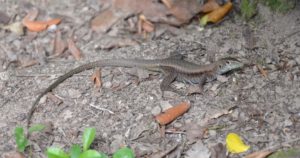
After this encounter, the divide between inside and outside seemed to melt away. Every day at least one ground lizard would enter my house and pitter patter around, using their long tongues to hoover up microscopic crumbs and insects off the floor. One morning, I left my door open ajar as I went for a walk around the garden. This garden walk or ‘commute’ became part of my morning routine, in an attempt to separate the ‘getting up’ portion of my morning from the day of work ahead.
As I’m sure many of you working from home can relate to, my commute used to give me time to settle into a work mindset and without it, the days sort of seemed to blur into one timeless stretch. I got back from the garden that day to find an enormous ground lizard sat on top of my laptop, which I’d left on the floor beside my bed the night before! Maybe he was trying to hint that I should get started on my work, but he looked to me like he had claimed it for his own, just like my cats like to do back at home. As I approached, he turned and scarpered out the front door, practically running on his hind legs!
The visits escalated and they only got more adventurous! One time, the familiar prehistoric-looking head peered around the corner of the front door, a long tongue flicking as the lizard slinked lazily inside. Thinking nothing of it, I let her walk around the flat as I worked. I had forgotten that she was there until I heard a loud rustling sound behind me, coming from the kitchen. I went to investigate and found the lizard INSIDE a packet of spaghetti that I’d left on a low-lying shelf. This was the final straw. She could hang out in my room, but making me throw away food was a step too far! I had to set some boundaries.
House Gecko (Hemidactylus mabouia)
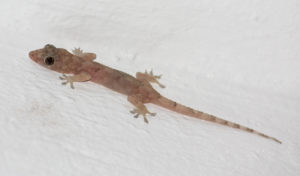
But it wasn’t just ground lizards who kept me company in lockdown. The next encounter happened as I sat eating my dinner one night, re-watching “Starter for 10” for the third time that week. I should probably explain here that I’m not quite as obsessive as that may sound. These were the days before I had Wi-Fi in my flat so I re-watched the same 4 DVDs until I could almost recite them word for word. “Starter for 10” still makes me laugh, so that really is a testament to how great of a film it is!
So as I was watching and eating, a tiny face appeared around the edge of the photo frame on the opposite wall. A house gecko. I’d seen them outside but I didn’t know that we were cohabiting until this point! With a flurry of frantic limbs and then the distinctive tail wiggle of a hunting lizard, the tiny mottled gecko zipped out from behind the frame and ate an ant off the wall. Within seconds, he had returned to his lair, once again becoming a scarcely visible pointed snout poking out from the frame. He licked his eyeball. Maybe it was the novelty of watching something other than the same 80s film about university challenge over and over again, but as far as I was concerned, this was first class entertainment.
Geckos of various sizes shared the space with me from that point onwards but none compared to the delight of seeing that first one.
Montserrat Galliwasp (Diploglossus montisserati)
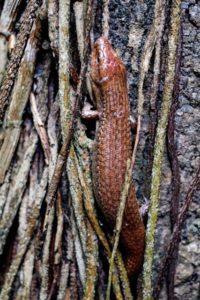
So although I became all too familiar with some species of lizard, there was one reptile that I longed to see above all else: the elusive galliwasp!
Smooth and distinctly skink-esque, with chunky bodies, a large head and small limbs, it’s something of a miracle that there have only been 11 confirmed sightings of the galliwasp in total, most of which are anecdotal sightings from people’s back gardens. In fact, most sightings have been from residents in one densely forested area of the island, who have been sat quietly reading books on their porches. This is a tantalising prospect, particularly as my flat boarders the same dense woodland that backs onto the Centre Hills Reserve, so I’m never quite sure what I might find in the bushes.
The galliwasp is so elusive that we know next to nothing about its life history and scientists aren’t even sure of a ballpark for its population size. Such mystery shrouds this creature that I feel like finding one would compare to discovering a dragon- at once combining my childhood dreams of being an intrepid explorer in unchartered lands and being a magizoologist like Newt Scamander. I often think that growing up on a steady diet of Harry Potter may have exacerbated my love for all things scaly or amphibious.
Needless to say, I was incredibly excited when we set off on our first galliwasp survey through the Duberry-Cassava trail. Luke, Kristofer and I set out as darkness fell, equipped with headtorches, spare batteries and somewhat optimistically a bag full of tools for measuring galliwasp biometrics.
As we set off, I had a real sense that tonight would be the night. Yes, this survey had been done many times before with no sightings, but for some reason I had a strong feeling that we would find one.
We hiked up the steep hill, scanning left and right for any sign of movement. We peered into every rock crevice and tree stump for signs of life. As expected, we found a huge number of tiny round treefrogs, inflating and deflating as they chirped their little hearts out.
Tailless Whip Scorpion (Amblypygi sp.)
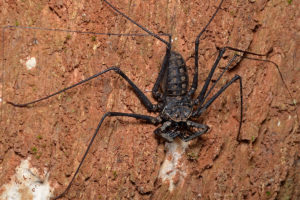
We also found a number of tailless whip scorpions, which are really bizarre-looking arachnids that technically don’t class as either scorpions or spiders, even though they look like a mashup of the two. I immediately recognised it from the Harry Potter films as the flat, spindly-legged creature that Mad Eye Moody uses to demonstrate the unforgiveable curses to his students. This may be what they are most famous for in the media, but in the forests of Montserrat they are kings of the foliage, at least until a lizard or bat tries to eat them. Despite their imposing appearance, tailless whip scorpions are predated by the majority of forest-dwelling creatures and are harmless to humans!
Tarantula Hawk (Pepsis sp.)
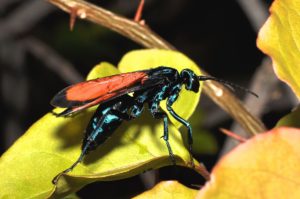
At one point along the trail, we came across a creature that is the stuff of nightmares. If you thought that the galliwasp is a strange name for a lizard, then prepare to be confused even further. This was the night that I had my first encounter with a tarantula hawk, which is neither a spider nor a bird of prey but a terrifying nocturnal wasp! The tarantula hawk is one of the world’s largest wasp species, its black and blue body measuring around 2 inches long, with a menacing stinger on its back end.
To put the tarantula hawk into perspective, it is so called because it predates on tarantulas- a voracious predator themselves. The hawk begins its torturous process by locating the white spot on the back of a tarantula’s body and stinging it. This sting paralyses the spider, where it is then dragged by the hawk into an underground lair. The hawk then lays an egg inside the tarantula’s abdomen and barricades up the lair, leaving its victim trapped inside. Once the larvae has hatched inside the tarantula’s abdomen, it eats it from the inside out, leaving the organs for as long as possible so the poor creature stays alive, and its flesh remains fresh for the pupae to eat. I don’t like to demonise animals for their natural behaviour, but this just seems excessively evil.
The problem with tarantula hawks is that they often confuse the white beam of a headtorch for the markings on a tarantula’s back and make a beeline for the face, stinging unsuspecting hikers. The sting is said to cause one of the most excruciating, electrifying pains inflicted by any insect, second only to a bite from a bullet ant. And to add insult to injury, the sting can even temporarily paralyse parts of the human body.
We had been told to be vigilant for their pungent, almost almondy smell, accompanied by a loud buzzing. These are good indicators that a tarantula hawk is nearby, as they are hard to spot in the darkness. The second you detect these signs, the best course of action is to switch your headtorch off immediately. As you can imagine, we really didn’t want to be stung by one of these wasps. I got a little paranoid and embarrassingly ended up switching off my headtorch in panic a few times after spotting moths fluttering near my face.
So when Luke shouted “Headtorches off!” about halfway through the survey, we managed to respond quickly. After a few moments of pitch blackness, he took off his headtorch and dangled it face down to the ground. Lo and behold, the light attracted the tarantula hawk to the spot of light on the floor where Luke crushed its body with his walking boot. This may seem cruel, but we were at serious risk of getting seriously hurt or temporarily paralysed if the wasp remained alive and risking an anaphylactic shock is one of the last things you want whilst working in the field at night. And believe me, there are a lot of them still thriving out there, so I’m sure we didn’t even dent the population. He told us that they are incredibly robust and often furiously fly back at you in anger even after being crushed, so you have to be thorough! However fascinating their biology may be, this is one creature I could do without seeing again!
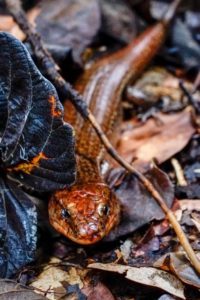
Eventually we reached the spot where we would do the main part of the survey. There’s a theory that galliwasps might live underground and so whilst we’re moving around, they will sense the vibrations of our footfall and hide away. Therefore, sitting silently in the pitch black could potentially make a galliwasp think that the coast is clear and venture out of the undergrowth. The three of us separated a short distance away from each other and sat down on the leafy ground. Then we switched off our headtorches. I don’t know why I’d expect anything else but it was pitch black! The kind of darkness where you can’t even see your hand in front of your face. Losing one of your senses really does accentuate the others: the chirping of crickets and peeping of treefrogs suddenly seemed to get even louder. I kept imagining that something was going to creep up behind me in the darkness but quickly realised that this was the whole point of the survey and my nerves relaxed into exhilaration. I often find the sounds of the forest at night soporific when I’m lying under my mosquito net, but that night they were a sign that anything could appear at any moment and I felt incredibly lucky to be sharing this moment with the wildlife.
The idea was that if you heard a sound that might be a galliwasp, you must quickly turn on your headtorch in the direction of the sound, temporarily startling it and triggering a freeze behaviour they display when threatened. This should buy us enough time, so we can catch it and examine it. As there is such a deficit of information regarding the galliwasp, we would take DNA samples, record weight and body measurements, take a number of photos and hopefully insert a PIT tag under its skin so that we could ascertain where this unusual species goes.
We stayed like this for around half an hour before switching stations and repeating the process a further 2 times. I did switch my headtorch on a couple of times, only to find ferns and leaves tapping on tree trunks in the wind. But unfortunately, no galliwasps. Nevertheless, it was exciting to know that they might just have been right there beneath the ground under our feet, secretive and elusive.
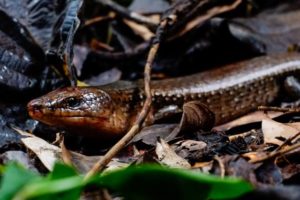
So unfortunately, we didn’t discover the secrets of the galliwasp that night, but I hold out hope that someday it will happen. Fortunately they have been spotted in the area as early as last Christmas (the source of all these wonderful photos), so I have high hopes that one day we will better understand this almost mythical part of Montserrat’s unique wildlife. Whether we find them or not, it is a privilege to share the island with such a diverse array of fantastic beasts!
[Cover Photo: Montserrat galliwasp (Diploglossus montisserati). Photo Credit: Beano]


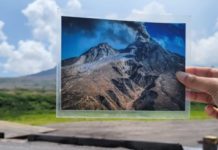

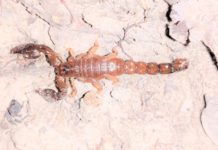


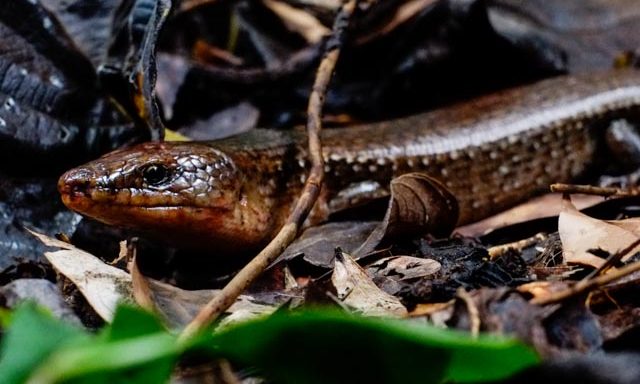
I absolutely loved reading the Fantastic Beasts blog- such a wonderful description of the varied wildlife on the island. More please!
Very interesting read! We hiked with Lloyd and Scriber to the petroglyphs in January 2023. It was special